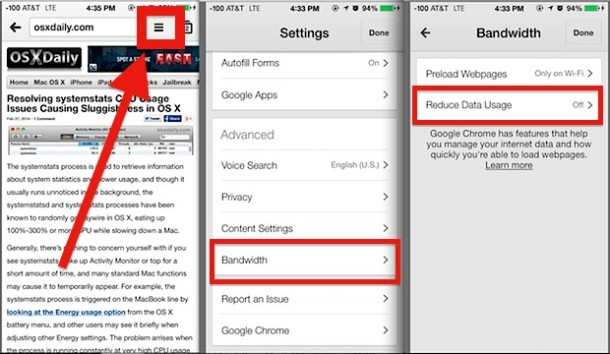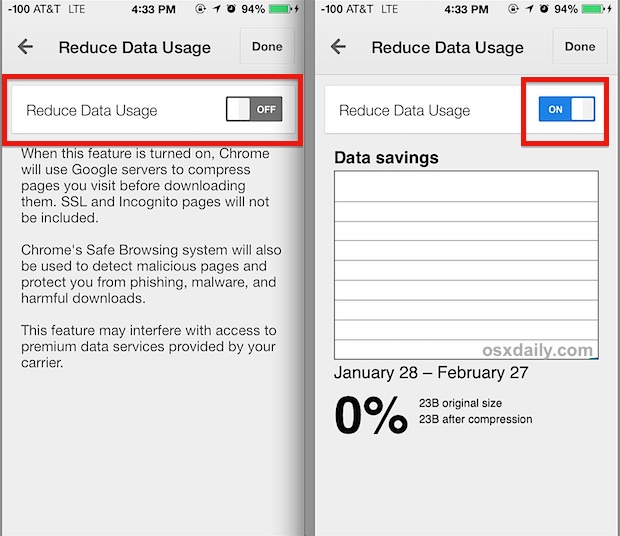Reduce Data Usage When Web Browsing on iPhone with Chrome
 The latest versions of Chrome for iOS offer an optional data compression feature that uses Google servers to further compress web pages visited before accessing them from your iPhone or iPad. Put simply, toggling this setting can help to reduce your cellular data consumption when browsing the web within the Chrome app for iOS, and for some users it may even offer a bit of a speed improvement to their mobile web browsing experience too.
The latest versions of Chrome for iOS offer an optional data compression feature that uses Google servers to further compress web pages visited before accessing them from your iPhone or iPad. Put simply, toggling this setting can help to reduce your cellular data consumption when browsing the web within the Chrome app for iOS, and for some users it may even offer a bit of a speed improvement to their mobile web browsing experience too.
This is a reasonably new feature, so you’ll need to update to the latest version of Chrome for iOS to get access to the feature. If you’re not sure if you have it, check the App Store for any updates and download what is available before beginning.
- Launch the Chrome app if you haven’t yet
- Go to any webpage, then access the Chrome Settings by tapping on the [=] menu button alongside the URL bar, choosing “Settings” from the pull-down menu options
- Scroll down near the bottom and select “Bandwidth”, then choose the “Reduce Data Usage” option
- Flip “Reduce Data Usage” to ON then tap “Done”
- Use Chrome as usual, the effect is automated


Once the feature has been turned on, the Data Usage settings panel in Chrome will convert into a ‘Data Savings’ graph, demonstrating the amount of bandwidth that has been saved by compressing pages before downloading them to the device.
As noted in the app Settings, neither SSL (secure sites and pages) or Incognito (anonymous browsing) pages are included in Chrome pre-compression.
Because most of the web is reasonably compressed these days, you’ll probably see between a 5%-15% reduction in bandwidth on average over time. That may not sound like much, but if you’re frequently hitting the data caps on your cellular plan and it’s because you’re browsing the web often, it can make a difference between getting whacked with overage charges or falling within the limits.
To be perfectly clear, this only impacts web browsing through the Chrome app in iOS, and it has no effect on any other form of data transfer through the iPhone or cellular iPad, and no impact on Safari. For the time being, this is limited to the mobile versions of Chrome, so if you rely on the personal wi-fi hotspot to tether your Mac to the phone and are running into excess data usage issues, you’ll need to follow some other tips to reduce that. Considering how handy this is, and how Chrome offers built-in bandwidth usage charting on the desktop through a hidden internal feature, it’s certainly possible the desktop Chrome apps will adopt such a feature in the future. We can hope the native Safari browser will get something similar too.


Great tip! Only a couple of things for me: Uses Chrome and Google servers.
Yeeaaaaah… I think I’ll just continue to be cautious with my browsing and keep an eye on my data usage, while exploiting the Hell outta any and all free WiFi I find.
A modicum of effort to avoid the bulwark of BS that is Google is worth it to me.
Good advice and a neat little trick on Google’s part! I love that Google can now know every single ‘bit’ of the internet that I look at, track me everywhere, profile me, sell that highly personal information (it’s no longer just data when it’s this comprehensive) to anyone they like, and most of all I love that sites like these don’t explain these costs AT ALL when offering pseudo advice!
Yes, you are reducing your bandwidth, but…
ALL you traffic (from chrome, of course) will be redirected to google proxy…
so, if privacy means nothing to you, you’re saving bandwidth
I use ad block in Safari to drastically reduce my bandwidth on the desktop. It blocks all the ads. I experimented and opened the same web pages in Safari and Chrome at the same time. More ads in Chrome. So the first step is eliminate Chrome. To finish the job use ad block in Safari. Two step process, great results.
This is about iPhone and iPad browsers though.
Or use adblock in Chrome as well.